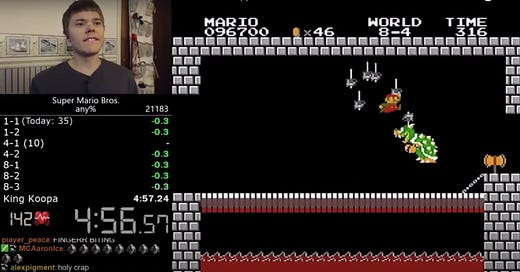There’s a set of writers and newsletters that I’ve drawn quite a bit of inspiration from over the years and Drew Austin’s (DA) Kneeling Bus is one of them. It sits at the intersection of technology and culture and consistently offers up angles and ideas that never would have crossed my mind but seem obvious in retrospect. Beyond the newsletter, Drew is a writer and urban planner who lives in Brooklyn. He posts his stray thoughts on Twitter and contributes longer essays at sites like Real Life. - Noah (NRB)
Drew here. I don’t really play video games anymore but I’ve become increasingly fascinated by speedrunning in recent years. A speedrun, if you’re not familiar, is the practice of beating a video game in the shortest possible amount of time (the current record for completing the original Super Mario Brothers game, for example, is just under 5 minutes, and players still compete to shave fractions of seconds off of that time. Wikipedia elaborates: “Speedrunners often have to reason about the game differently from the way that ordinary players might. Speedruns follow gameplay routes that are planned out carefully and often involve disarranging the intended sequence of events or skipping entire parts of it. Other speedruns exploit programming mistakes, or glitches, that a skillful player can exploit to their advantage.” One popular type of glitch that players utilize involves “clipping” through walls, a time-saving action that normal gameplay doesn’t allow. The practice of speedrunning is remarkably expansive; as Harry Gowland wrote in a recent issue of Dirt, “you can speedrun anything,” even non-games like the calculator app on the Nintendo Switch console (counting to 1,000 by frantically clicking +1). “If you add a layer of interactivity to almost any program, someone will try and speedrun it.” You can probably speedrun Microsoft Excel. OK, I just googled it—you can.
Why is this interesting?
There are many ways of looking at speedrunning: a game within a game that mocks the latter’s actual objectives; a deep exploration of a digital environment’s contours; or a supreme waste of time, intentionally pointless outside of its own context and even dumber than the overarching game itself, a nihilistic statement that forces us to question the ultimate purpose of anything. It’s games all the way down. Like so many other recent cultural events—WallStreetBets and meme stocks are a notable example—speedrunning demonstrates that anything can be turned into a game, whether it’s meant to be or not. Even games themselves can be turned into other games. In a world where our experience is increasingly mediated by software, seemingly every facet of life is abstracted as bits and thus feels more gamelike; speedrunning provides an eloquent expression of that. The logic of games increasingly pervades culture, a phenomenon Sean Monahan calls gamer bait, and anything arrogant enough to pretend it’s not a game, such as the stock market, simply entices the masses to expose the fallacy all the more aggressively. Acknowledging the game does little to preempt this either, as speedrunners demonstrate, overwriting the stated objectives, imposing their own terms, and glitching across virtual space. We’ll be speedrunning Robinhood soon.
Despite its apparent superficiality, speedrunning presents a unified worldview, a logic that can be applied to any environment, a principle that transcends any specific game: Everything is topological. Game environments provide an ideal space in which to learn and grapple with its implications. Arbitrarily traveling from point A to point B as quickly as possible, whether skiing or speedrunning, requires a maximum understanding of the landscape being traversed. In a 2020 Baffler essay, Evan Malmgren wrote, “To play a video game is to embody a sequence of possibilities in an engineered, enclosed micro-reality…(Speedrunners) are less like marathon runners than explorers charting the hard limits of a man-made environment, whether they’re searching for sequence breaks to skip sections of games, planning optimized movement paths, mining for glitches to clip through walls, or practicing the mechanics of lightning-fast menu navigation. Speedrunners don’t simply go fast. They are the cosmologists of sandbox universes.” Perhaps, as our lived experience becomes more digital and more gamified, these exploratory efforts will prove to be relevant beyond the boundaries of the environments being speedrun—not just games within games but basic research about the texture of reality itself. (DA)
Chart of the Day:
Via The Economist. (CJN)
Quick Links:
Watch McLaren F1—Inspired Gordon Murray T.50 on the Track (NRB)
Video of John Boyd (inventor of the OODA loop) delivering his “Patterns of Conflict” talk (NRB)
[Sponsored Link] If you’re at a SaaS company, check out Variance. It’s a tool to help grow customers (some people are calling it a PLG CRM). If you have questions or want to try it, get in touch. (NRB)
Thanks for reading,
Noah (NRB) & Colin (CJN) & Drew (DA)
—
Why is this interesting? is a daily email from Noah Brier & Colin Nagy (and friends!) about interesting things. If you’ve enjoyed this edition, please consider forwarding it to a friend. If you’re reading it for the first time, consider subscribing (it’s free!).




